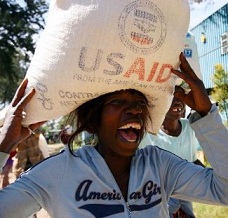
FAMINE, GLOBAL POVERTY AND THE DESTRUCTION OF THE FAMILY FARM

he fundamental causes of famine and poverty are rarely exposed in the mainstream media and too often obfuscated by an unconsciously racist worldview in which people in underdeveloped countries are the authors of their own misfortunes. The underlying economic and social roots of poverty are actually the expression of centuries of domination of the North over the South.
To honestly address poverty issues would require a fundamental reform in an unfair global economic system based, among other things, on the outright takeover of farming by corporate agribusiness, leading to the social demise of large sectors of the rural population.
Instead, dominant economic forces push for more destructive policies, feign compassion and generosity with empty promises like “Millennium Development Goals” and subsidies to international NGOs which are used to hide the devastation.
“Hunger and malnutrition are man-made,” Dr. Vandana Shiva explains:
They are hardwired in the design of the industrial, chemical model of agriculture. But just as hunger is created by design, healthy and nutritious food for all can also be designed, through food democracy [...]
We are repeatedly told that we will starve without chemical fertilisers. However, chemical fertilisers, which are essentially poison, undermine food security by destroying the fertility of soil by killing the biodiversity of soil organisms, friendly insects that control pests and pollinators like bees and butterflies necessary for plant reproduction and food production [...]
Industrialisation of agriculture creates hunger and malnutrition, and yet further industrialisation of food systems are offered as solution to the crisis. (Dr. Vandana Shiva, Our Hunger Games )
In this for profit economy, pesticides are good for businesses. That they are harmful to living species, including humans, is the last thing on the corporate money-maker’s mind:
The next time anyone in India serves up a good old ‘wholesome’ meal of rice and various vegetables, they will probably take in half a milligram of pesticide also, around a pin prick. That would be more than 40 times what an average North American person would consume.
India is one of the world’s largest users of pesticides and a highly profitable market for the corporations that manufacture them. Ladyfinger, cabbage, tomato and cauliflower in particular may contain dangerously high levels because farmers tend to harvest them almost immediately after spraying. Fruit and vegetables are sprayed and tampered with to make them more colourful, and harmful fungicides are sprayed on fruit to ripen them in order to rush them off to market. (Colin Todhunter, Slow Death and Fast Profits: The Globalisation of Pesticides and Poison)
In addition, through speculation in commodity futures market, financial institutions are instrumental in the impoverishment of Third World countries.
It may sound surprising to some people, but it’s true that banks are not allowed to trade in commodities in India [...] The Banking Regulation Act of 1949 strictly prohibits banks (both domestic and foreign) from trading in goods and therefore they are not allowed to trade in commodity futures market [...]
With the rapid liberalisation of Indian securities markets, pressure is exerted by big foreign banks — who have considerable international experience and expertise in commodity derivatives trading — to allow their entry in the commodity markets [...]
Even though there are various causes of high food inflation in India, the role of futures trading has remained contentious. In 2007, New Delhi had suspended the futures trading in key agricultural commodities due to their alleged role in triggering rapid price hike [...] (Kavaljit Singh, Should Banks Be Allowed in Commodity Futures Trading? India’s Experience)
In turn, we are led to believe that the IMF austerity measures which, since the 1980s, have led to the destruction of Third World economies, are somehow the incontrovertible solutionway out of the financial crisis hitting the so-called developed economies.
Wherever it has been applied, throughout the developing World, IMF’s “economic medicine” has sabotaged and destroyed food self-sufficiency: markets were opened by lowering trade barriers allowing the dumping of heavily subsidised food staples produced in the rich countries. Unable to offer competitive prices, local farmers were driven into bankruptcy.
This chain of events led to dependency on “food aid”, largely distributed by Western NGOs, leading to wider market shares for multinationals.
And yet there is a lot of hidden wealth by the very same people who are calling for the adoption of austerity measures.
A new Tax Justice Network (TJN) USA report reveals an estimated $21 – $32 trillion of hidden and stolen wealth stashed largely tax-free secretly.
Titled “The Price of Offshore Revisited,” it explains what financial insiders know but won’t discuss. Many of them have their own hidden wealth.
TJN describes a “subterranean” systemic “economic equivalent of an astrophysical black hole.” The higher estimate above exceeds US GDP twofold.
It’s mind-boggling. It’s hard imagining a tiny percent of privileged elites control this much wealth secretly. It’s worse knowing it’s largely tax free. It’s appalling that governments let them get away with it. (Stephen Lendman, Trillions Stashed in Offshore Tax Havens)
Here is a list of selected Global Research articles pertaining to the global food industry, the economic crisis and the plight of farmers in developing countries.
http://www.globalresearch.ca/famine-global-poverty-and-the-destruction-of-the-family-farm/
